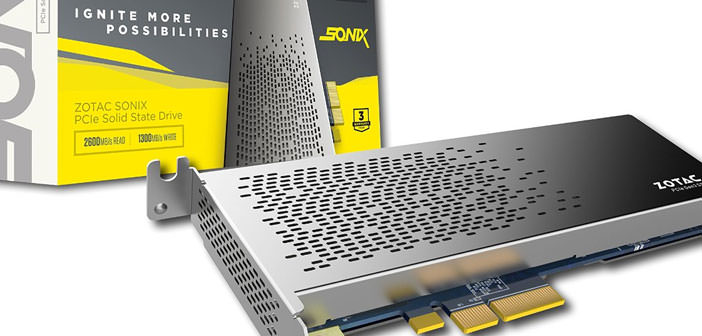Reveals some additional information about the new Zotac Sonix SSD 480GB PCIe SSD, designed for the desktop world and for customers looking for the highest performance. Recall that the form factor is that ” from the video card “, HHHL and that the interface is of type PCIe 3.0 x4.
We have already had occasion to speak of the new SSD Zotac high performance for the home desktop world: we are talking about the model Zotac Sonix PCIe 480GB SSD, a solid-state drive form factor and HHHL PCIe 3.0 x4 interface, which allows you to push the speed of reading and writing well over 600 MB/s theoretical SATA 6Gbps. Specifically, Zotac says well 2300 MB/s read and 1300 MB/s write, thus making it an SSD really coveted for fans.
Anandtech reported some additional information that we report for completeness of information. Important information comes, for example on the front controller: the PS5007-E7 Phison already we have mentioned in previous news is credited with 8 channels, with performance of up to 300,000 IOPS read and 200,000 IOPS.
The final firmware for the controller is dated the end of February, and very up to date. It also adds an interesting note, or that Phison not only provides the controller, but the ” complete package ” consisting of NAND Flash chips and firmware.
Said in other words: Zotac puts the brand of a product developed in practice from Phison, that cure both the type of NAND flash to be integrated (in this case Toshiba MLC), both the firmware, either the entire production process. Emerge also information on consumption, which settles on 0.5 W at idle and 5.57 W and 7.27 W respectively during reading and writing.
Price? It comes to $ 369.99, you need to get at least a rough idea. We are about forty dollars more than the Samsung 950 Pro 512 GB M.2 with equal performance but M.2 interface. Honestly, we expected something less, but it is early to say what will be offered in Europe.
The distribution channel, also, can affect much. One of the advantages over the Samsung model is that Zotac Sonix can be used in desktop systems without need of an M.2 slot (only available in newer motherboards models).



